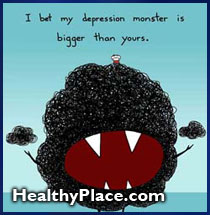Depression Research at NIMH
 Depressive disorders affect approximately 19 million American adults. The suffering endured by people with depression and the lives lost to suicide attest to the great burden of this disorder on individuals, families, and society. Improved recognition, treatment, and prevention of depression are critical public health priorities. The National Institute of Mental Health (NIMH), the world's leading mental health biomedical organization, conducts and supports research on the causes, diagnosis and treatment of depression and the prevention of depression.
Depressive disorders affect approximately 19 million American adults. The suffering endured by people with depression and the lives lost to suicide attest to the great burden of this disorder on individuals, families, and society. Improved recognition, treatment, and prevention of depression are critical public health priorities. The National Institute of Mental Health (NIMH), the world's leading mental health biomedical organization, conducts and supports research on the causes, diagnosis and treatment of depression and the prevention of depression.
Evidence from neuroscience, genetics, and clinical investigation demonstrate that depression is a disorder of the brain. Modern brain imaging technologies are revealing that in depression, neural circuits responsible for the regulation of moods, thinking, sleep, appetite, and behavior fail to function properly, and that critical neurotransmitters - chemicals used by nerve cells to communicate - are out of balance. Genetics research indicates that vulnerability to depression results from the influence of multiple genes acting together with environmental factors. Studies of brain chemistry and of mechanisms of action of antidepressant medications continue to inform the development of new and better treatments.
In the past decade, there have been significant advances in our ability to investigate brain function at multiple levels. NIMH is collaborating with various scientific disciplines to effectively utilize the tools of molecular and cellular biology, genetics, epidemiology, and cognitive and behavioral science to gain a more thorough and comprehensive understanding of the factors that influence brain function and behavior, including mental illness. This collaboration reflects the Institute's increasing focus on "translational research," whereby basic and clinical scientists are involved in joint efforts to translate discoveries and knowledge into clinically relevant questions and targets of research opportunity. Translational research holds great promise for disentangling the complex causes of depression and other mental disorders and for advancing the development of more effective treatments.
Symptoms and Types of Depression
Symptoms of depression include a persistent sad mood; loss of interest or pleasure in activities that were once enjoyed; significant change in appetite or body weight; difficulty sleeping or oversleeping; physical slowing or agitation; loss of energy; feelings of worthlessness or inappropriate guilt; difficulty thinking or concentrating; and recurrent thoughts of death or suicide. A diagnosis of major depressive disorder (or unipolar major depression) is made if an individual has five or more of these symptoms during the same two-week period. Unipolar major depression typically presents in discrete episodes that recur during a person's lifetime.
Bipolar disorder (or manic-depressive illness) is characterized by episodes of major depression as well as episodes of mania - periods of abnormally and persistently elevated mood or irritability accompanied by at least three of the following symptoms: overly-inflated self-esteem; decreased need for sleep; increased talkativeness; racing thoughts; distractibility; increased goal-directed activity or physical agitation; and excessive involvement in pleasurable activities that have a high potential for painful consequences. While sharing some of the features of major depression, bipolar disorder is a different illness that is discussed in detail in a separate NIMH publication.
Dysthymic disorder (or dysthymia), a less severe yet typically more chronic form of depression, is diagnosed when depressed mood persists for at least two years in adults (one year in children or adolescents) and is accompanied by at least two other depressive symptoms. Many people with dysthymic disorder also experience major depressive episodes. While unipolar major depression and dysthymia are the primary forms of depression, a variety of other subtypes exist.
In contrast to the normal emotional experiences of sadness, loss, or passing mood states, depression is extreme and persistent and can interfere significantly with an individual's ability to function. In fact, a recent study sponsored by the World Health Organization and the World Bank found unipolar major depression to be the leading cause of disability in the United States and worldwide.
There is a high degree of variation among people with depression in terms of symptoms, course of illness, and response to treatment, indicating that depression may have a number of complex and interacting causes. This variability poses a major challenge to researchers attempting to understand and treat the disorder. However, recent advances in research technology are bringing NIMH scientists closer than ever before to characterizing the biology and physiology of depression in its different forms and to the possibility of identifying effective treatments for individuals based on symptom presentation.
The National Institute of Mental Health (NIMH) is one of 25 components of the National Institutes of Health (NIH), the Government's principal biomedical and behavioral research agency. NIH is part of the U.S. Department of Health and Human Services. The actual total fiscal year 1999 NIMH budget was $859 million.
NIMH Mission
To reduce the burden of mental illness through research on mind, brain, and behavior.
How Does the Institute Carry Out Its Mission?
One of the most challenging problems in depression research and clinical practice is refractory - hard to treat - depression (treatment-resistant depression). While approximately 80 percent of people with depression respond very positively to treatment, a significant number of individuals remain treatment refractory. Even among treatment responders, many do not have complete or lasting improvement, and adverse side effects are common. Thus, an important goal of NIMH research is to advance the development of more effective treatments for depression - especially treatment-refractory depression - that also have fewer side effects than currently available treatments.
Research on Treatments for Depression
Antidepressant Medication
Studies on the mechanisms of action of antidepressant medication comprise an important area of NIMH depression research. Existing antidepressant drugs are known to influence the functioning of certain neurotransmitters in the brain, primarily serotonin and norepinephrine, known as monoamines. Older medications - tricyclic antidepressants (TCAs) and monoamine oxidase inhibitors (MAOIs) - affect the activity of both of these neurotransmitters simultaneously. Their disadvantage is that they can be difficult to tolerate due to side effects or, in the case of MAOIs, dietary restrictions. Newer medications, such as the selective serotonin reuptake inhibitors (SSRIs), have fewer side effects than the older drugs, making it easier for patients to adhere to treatment. Both generations of medications are effective in relieving depression, although some people will respond to one type of drug, but not another.
Antidepressant medications take several weeks to be clinically effective even though they begin to alter brain chemistry with the very first dose. Research now indicates that antidepressant effects result from slow-onset adaptive changes within the brain cells, or neurons. Further, it appears that activation of chemical messenger pathways within neurons, and changes in the way that genes in brain cells are expressed, are the critical events underlying long-term adaptations in neuronal function relevant to antidepressant drug action. A current challenge is to understand the mechanisms that mediate, within cells, the long-term changes in neuronal function produced by antidepressants and other psychotropic drugs and to understand how these mechanisms are altered in the presence of illness.
Knowing how and where in the brain antidepressants work can aid the development of more targeted and potent medications that may help reduce the time between first dose and clinical response. Further, clarifying the mechanisms of action can reveal how different drugs produce side effects and can guide the design of new, more tolerable, treatments.
As one route toward learning about the distinct biological processes that go awry in different forms of depression, NIMH researchers are investigating the differential effectiveness of various antidepressant medications in people with particular subtypes of depression. For example, this research has revealed that people with atypical depression, a subtype characterized by reactivity of mood (mood brightens in response to positive events) and at least two other symptoms (weight gain or increased appetite, oversleeping, intense fatigue, or rejection sensitivity), respond better to treatment with MAOIs, and perhaps with SSRIs than with TCAs.
Many patients and clinicians find that combinations of different drugs work most effectively for treating depression, either by enhancing the therapeutic action or reducing side effects. Although combination strategies are used often in clinical practice, there is little research evidence available to guide psychiatrists in prescribing appropriate combination treatment. NIMH is in the process of revitalizing and expanding its program of clinical research, and combination therapy will be but one of numerous treatment interventions to be explored and developed.
Untreated depression often has an accelerating course, in which episodes become more frequent and severe over time. Researchers are now considering whether early intervention with medications and maintenance treatment during well periods will prevent recurrence of episodes. To date, there is no evidence of any adverse effects of long-term antidepressant use.
Psychotherapy
Like the process of learning, which involves the formation of new connections between nerve cells in the brain, psychotherapy works by changing the way the brain functions. NIMH research has shown that certain types of psychotherapy, particularly cognitive-behavioral therapy (CBT) and interpersonal therapy (IPT), can help relieve depression. CBT helps patients change the negative styles of thinking and behaving often associated with depression. IPT focuses on working through disturbed personal relationships that may contribute to depression.
Research on children and adolescents with depression supports CBT as a useful initial treatment, but antidepressant medication is indicated for those with severe, recurrent, or psychotic depression. Studies of adults have shown that while psychotherapy alone is rarely sufficient to treat moderate to severe depression, it may provide additional relief in combination with antidepressant medication. In one recent NIMH-funded study, older adults with recurrent major depression who received IPT in combination with an antidepressant medication during a three-year period were much less likely to experience a recurrence of illness than those who received medication only or therapy only. For mild depression, however, a recent analysis of multiple studies indicated that combination treatment is not significantly more effective than CBT or IPT alone.
Preliminary evidence from an ongoing NIMH-supported study indicates that IPT may hold promise in the treatment of dysthymia.
Electroconvulsive Therapy (ECT)
Electroconvulsive therapy (ECT) remains one of the most effective yet most stigmatized treatments for depression. Eighty to ninety percent of people with severe depression improve dramatically with ECT. ECT involves producing a seizure in the brain of a patient under general anesthesia by applying electrical stimulation to the brain through electrodes placed on the scalp. Repeated treatments are necessary to achieve the most complete antidepressant response. Memory loss and other cognitive problems are common, yet typically short-lived side effects of ECT. Although some people report lasting difficulties, modern advances in ECT technique have greatly reduced the side effects of this treatment compared to earlier decades. NIMH research on ECT has found that the dose of electricity applied and the placement of electrodes (unilateral or bilateral) can influence the degree of depression relief and the severity of side effects.
A current research question is how best to maintain the benefits of ECT over time. Although ECT can be very effective for relieving acute depression, there is a high rate of relapse when the treatments are discontinued. NIMH is currently sponsoring two multicenter studies on ECT follow-up treatment strategies. One study is comparing different medication treatments, and the other study is comparing maintenance medication to maintenance ECT. Results from these studies will help guide and improve follow-up treatment plans for patients who respond well to ECT.
Genetics Research
Research on the genetics of depression and other mental illnesses is a priority of NIMH and constitutes a critical component of the Institute's multi-level research effort. Researchers are increasingly certain that genes play an important role in vulnerability to depression and other severe mental disorders.
In recent years, the search for a single, defective gene responsible for each mental illness has given way to the understanding that multiple gene variants, acting together with yet unknown environmental risk factors or developmental events, account for the expression of psychiatric disorders. Identification of these genes, each of which contributes only a small effect, has proven extremely difficult.
However, new technologies, which continue to be developed and refined, are beginning to allow researchers to associate genetic variations with disease. In the next decade, two large-scale projects that involve identifying and sequencing all human genes and gene variants will be completed and are expected to yield valuable insights into the causes of mental disorders and the development of better treatments. In addition, NIMH is currently soliciting researchers to contribute to the development of a large-scale database of genetic information that will facilitate efforts to identify susceptibility genes for depression and other mental disorders.
Stress and Depression
Psychosocial and environmental stressors are known risk factors for depression. NIMH research has shown that stress in the form of loss, especially death of close family members or friends, can trigger depression in vulnerable individuals. Genetics research indicates that environmental stressors interact with depression vulnerability genes to increase the risk of developing depressive illness. Stressful life events may contribute to recurrent episodes of depression in some individuals, while in others depression recurrences may develop without identifiable triggers.
Other NIMH research indicates that stressors in the form of social isolation or early-life deprivation may lead to permanent changes in brain function that increase susceptibility to depressive symptoms.
Brain Imaging
Recent advances in brain imaging technologies are allowing scientists to examine the brain in living people with more clarity than ever before. Functional magnetic resonance imaging (fMRI), a safe, noninvasive method for viewing brain structure and function simultaneously, is one new technique that NIMH researchers are using to study the brains of individuals with and without mental disorders. This technique will enable scientists to evaluate the effects of a variety of treatments on the brain and to associate these effects with clinical outcome.
Brain imaging findings may help direct the search for microscopic abnormalities in brain structure and function responsible for mental disorders. Ultimately, imaging technologies may serve as tools for early diagnosis and subtyping of depression and other mental disorders, thus advancing the development of new treatments and evaluation of their effects.
Hormonal Abnormalities
The hormonal system that regulates the body's response to stress, the hypothalamic-pituitary-adrenal (HPA) axis, is overactive in many patients with depression, and NIMH researchers are investigating whether this phenomenon contributes to the development of the illness.
The hypothalamus, the brain region responsible for managing hormone release from glands throughout the body, increases production of a substance called corticotropin releasing factor (CRF) when a threat to physical or psychological well-being is detected. Elevated levels and effects of CRF lead to increased hormone secretion by the pituitary and adrenal glands which prepares the body for defensive action. The body's responses include reduced appetite, decreased sex drive, and heightened alertness. NIMH research suggests that persistent overactivation of this hormonal system may lay the groundwork for depression. The elevated CRF levels detectable in depressed patients are reduced by treatment with antidepressant drugs or ECT, and this reduction corresponds to improvement in depressive symptoms.
NIMH scientists are investigating how and whether the hormonal research findings fit together with the discoveries from genetics research and monoamine studies.
Co-occurrence of Depression and Anxiety Disorders
NIMH research has revealed that depression often co-exists with anxiety disorders (panic disorder, obsessive-compulsive disorder, post-traumatic stress disorder, social phobia, or generalized anxiety disorder). In such cases, it is important that depression and each co-occurring illness be diagnosed and treated.
everal studies have shown an increased risk of suicide attempts in people with co-occurring depression and panic disorder - the anxiety disorder characterized by unexpected and repeated episodes of intense fear and physical symptoms, including chest pain, dizziness, and shortness of breath.
Rates of depression are especially high in people with post-traumatic stress disorder (PTSD), a debilitating condition that can occur after exposure to a terrifying event or ordeal in which grave physical harm occurred or was threatened. In one study supported by NIMH, more than 40 percent of patients with PTSD had depression when evaluated both at one month and four months following the traumatic event.
Co-occurrence of Depression and Other Illnesses
Depression frequently co-occurs with a variety of other physical illnesses, including heart disease, stroke, cancer, and diabetes, and also can increase the risk for subsequent physical illness, disability, and premature death. Depression in the context of physical illness, however, is often unrecognized and untreated. Furthermore, depression can impair the ability to seek and stay on treatment for other medical illnesses. NIMH research suggests that early diagnosis and treatment of depression in patients with other physical illnesses may help improve overall health outcome.
The results of a recent NIMH-supported study provide the strongest evidence to date that depression increases the risk of having a future heart attack. Analysis of data from a large-scale survey revealed that individuals with a history of major depression were more than four times as likely to suffer a heart attack over a 12-13 year follow-up period, compared to people without such a history. Even people with a history of two or more weeks of mild depression were more than twice as likely to have a heart attack, compared to those who had had no such episodes. Although associations were found between certain psychotropic medications and heart attack risk, the researchers determined that the associations were simply a reflection of the primary relationship between depression and heart trouble. The question of whether treatment for depression reduces the excess risk of heart attack in depressed patients must be addressed with further research.
NIMH is planning to present a major conference with other NIH Institutes on depression and co-occurring illnesses. The outcomes of this conference will guide NIMH investigation of depression both as a contributing factor to other medical illnesses and as a result of these illnesses.
Women and Depression
Nearly twice as many women (12 percent) as men (7 percent) are affected by a depressive illness each year. At some point during their lives, as many as 20 percent of women have at least one episode of depression that should be treated. Although conventional wisdom holds that depression is most closely associated with menopause, in fact, the childbearing years are marked by the highest rates of depression, followed by the years prior to menopause.
NIMH researchers are investigating the causes and treatment of depressive disorders in women. One area of research focuses on life stress and depression. Data from a recent NIMH-supported study suggests that stressful life experiences may play a larger role in provoking recurrent episodes of depression in women than in men.
The influence of hormones on depression in women has been an active area of NIMH research. One recent study was the first to demonstrate that the troublesome depressive mood swings and physical symptoms of premenstrual syndrome (PMS), a disorder affecting three to seven percent of menstruating women, result from an abnormal response to normal hormone changes during the menstrual cycle. Among women with normal menstrual cycles, those with a history of PMS experienced relief from mood and physical symptoms when their sex hormones, estrogen and progesterone, were temporarily "turned off" by administering a drug that suppresses the function of the ovaries. PMS symptoms developed within a week or two after the hormones were re-introduced. In contrast, women without a history of PMS reported no effects of the hormonal manipulation. The study showed that female sex hormones do not cause PMS - rather, they trigger PMS symptoms in women with a preexisting vulnerability to the disorder. The researchers currently are attempting to determine what makes some women but not others susceptible to PMS. Possibilities include genetic differences in hormone sensitivity at the cellular level, differences in history of other mood disorders, and individual differences in serotonin function.
NIMH researchers also are currently investigating the mechanisms that contribute to depression after childbirth (postpartum depression), another serious disorder where abrupt hormonal shifts in the context of intense psychosocial stress disable some women with an apparent underlying vulnerability. In addition, an ongoing NIMH clinical trial is evaluating the use of antidepressant medication following delivery to prevent postpartum depression in women with a history of this disorder after a previous childbirth.
Child and Adolescent Depression
Large-scale research studies have reported that up to 2.5 percent of children and up to 8.3 percent of adolescents in the United States suffer from depression. In addition, research has discovered that depression onset is occurring earlier in individuals born in more recent decades. There is evidence that depression emerging early in life often persists, recurs, and continues into adulthood, and that early onset depression may predict more severe illness in adult life. Diagnosing and treating children and adolescents with depression is critical to prevent impairment in academic, social, emotional, and behavioral functioning and to allow children to live up to their full potential.
Research on the diagnosis and treatment of mental disorders in children and adolescents, however, has lagged behind that in adults. Diagnosing depression in these age groups is often difficult because early symptoms can be hard to detect or may be attributed to other causes. In addition, treating depression in children and adolescents remains a challenge, because few studies have established the safety and efficacy of treatments for depression in youth. Children and adolescents are going through rapid, age-related changes in their physiological states, and there remains much to be learned about brain development during the early years of life before treatments for depression in young people will be as successful as they are in older people. NIMH is pursuing brain-imaging research in children and adolescents to gather information about normal brain development and what goes wrong in mental illness.
Depression in children and adolescents is associated with an increased risk of suicidal behaviors. Over the last several decades, the suicide rate in young people has increased dramatically. In 1996, the most recent year for which statistics are available, suicide was the third leading cause of death in 15-24 year olds and the fourth leading cause among 10-14 year olds. NIMH researchers are developing and testing various interventions to prevent suicide in children and adolescents. However, early diagnosis and treatment of depression and other mental disorders, and accurate evaluation of suicidal thinking, possibly hold the greatest suicide prevention value.
Until recently, there were limited data on the safety and efficacy of antidepressant medications in children and adolescents. The use of antidepressants in this age group was based on adult standards of treatment. A recent NIMH-funded study supported fluoxetine, an SSRI, as a safe and efficacious medication for child and adolescent depression. The response rate was not as high as in adults, however, emphasizing the need for continued research on existing treatments and for development of more effective treatments, including psychotherapies designed specifically for children. Other complementary studies in the field are beginning to report similar positive findings in depressed young people treated with any of several newer antidepressants. In a number of studies, TCAs were found to be ineffective for treating depression in children and adolescents, but limitations of the study designs preclude strong conclusions.
NIMH is committed to developing an infrastructure of skilled researchers in the areas of child and adolescent mental health. In 1995, NIMH co-sponsored a conference that brought together more than 100 research experts, family and patient advocates, and representatives of mental health professional organizations to discuss and reach consensus on various recommendations for psychiatric medication research in children and adolescents. Outcomes of this conference included awarding additional funds to existing research grants to study psychotropic medications in children and adolescents and establishing a network of Research Units of Pediatric Psychopharmacology (RUPPs). Recently, a large, multi-site, NIMH-funded study was initiated to investigate both medication and psychotherapeutic treatments for adolescent depression.
Continuing to address and resolve the ethical challenges involved with clinical research on children and adolescents is an NIMH priority.
Older Adults and Depression
In a given year, between one and two percent of people over age 65 living in the community, i.e., not living in nursing homes or other institutions, suffer from major depression and about two percent have dysthymia. Depression, however, is not a normal part of aging. Research has clearly demonstrated the importance of diagnosing and treating depression in older persons. Because major depression is typically a recurrent disorder, relapse prevention is a high priority for treatment research. As noted previously, a recent NIMH-supported study established the efficacy of combined antidepressant medication and interpersonal psychotherapy in reducing depressive relapses in older adults who had recovered from an episode of depression.
Additionally, recent NIMH studies show that 13 to 27 percent of older adults have subclinical depressions that do not meet the diagnostic criteria for major depression or dysthymia but are associated with increased risk of major depression, physical disability, medical illness, and high use of health services. Subclinical depressions cause considerable suffering, and some clinicians are now beginning to recognize and treat them.
Suicide is more common among the elderly than in any other age group. NIMH research has shown that nearly all people who commit suicide have a diagnosable mental or substance abuse disorder. In studies of older adults who committed suicide, nearly all had major depression, typically a first episode, though very few had a substance abuse disorder. Suicide among white males aged 85 and older was nearly six times the national U.S. rate (65 per 100,000 compared with 11 per 100,000) in 1996, the most recent year for which statistics are available. Prevention of suicide in older adults is a high priority area in the NIMH prevention research portfolio.
Alternative Treatments
There is high public interest in herbal remedies for various medical conditions including depression. Among the herbals is hypericum or St. John's wort, promoted as having antidepressant effects. Adverse drug interactions have been reported between St. John's wort and drugs used to treat HIV infections as well as those used to reduce the risk of organ transplant rejection. In general, preparations of St. John's wort vary significantly. No adequate studies have been done to determine the antidepressant efficacy of the herbal. Consequently, the NIMH has co-sponsored the first large-scale, multi-site, controlled study of St. John's wort as a potential treatment for depression. Results from this study are expected in 2001.
The Future of NIMH Depression Research
Research on the causes, treatment, and prevention of all forms of depression will remain a high NIMH priority for the foreseeable future. Areas of interest and opportunity include the following:
-
NIMH researchers will seek to identify distinct subtypes of depression characterized by various features including genetic risk, course of illness, and clinical symptoms. The aims of this research will be to enhance clinical prediction of onset, recurrence, and co-occurring illness; to identify the influence of environmental stressors in people with genetic vulnerability for major depression; and to prevent the development of co-occurring physical illnesses and substance use disorders in people with primary recurrent depression.
-
Because many adult mental disorders originate in childhood, studies of development over time that uncover the complex interactions among psychological, social, and biological events are needed to track the persistence, chronicity, and pathways into and out of disorders in childhood and adolescence. Information about behavioral continuities that may exist between specific dimensions of child temperament and child mental disorder, including depression, may make it possible to ward off adult psychiatric disorders.
-
Recent research on thought processes that has provided insights into the nature and causes of mental illness creates opportunities for improving prevention and treatment. Among the important findings of this research is evidence that points to the role of negative attentional and memory biases - selective attention to and memory of negative information - in producing and sustaining depression and anxiety. Future studies are needed to obtain a more precise account of the content and life course development of these biases, including their interaction with social and emotional processes, and their neural influences and effects.
-
Advances in neurobiology and brain imaging technology now make it possible to see clearer linkages between research findings from different domains of emotion and mood. Such "maps" of depression will inform understanding of brain development, effective treatments, and the basis for depression in children and adults. In adult populations, charting physiological changes involved in emotion during aging will shed light on mood disorders in the elderly, as well as the psychological and physiological effects of bereavement.
-
An important long-term goal of NIMH depression research is to identify simple biological markers of depression that, for example, could be detected in blood or with brain imaging. In theory, biological markers would reveal the specific depression profile of each patient and would allow psychiatrists to select treatments known to be most effective for each profile. Although such data-driven interventions can only be imagined today, NIMH already is investing in multiple research strategies to lay the groundwork for tomorrow's discoveries.
The Broad NIMH Research Program
In addition to studying depression, NIMH supports and conducts a broad based, multidisciplinary program of scientific inquiry aimed at improving the diagnosis, prevention, and treatment of other mental disorders. These conditions include bipolar disorder, clinical depression, and schizophrenia.
Increasingly, the public as well as health care professionals are recognizing these disorders as real and treatable medical illnesses of the brain. Still, more research is needed to examine in greater depth the relationships among genetic, behavioral, developmental, social and other factors to find the causes of these illnesses. NIMH is meeting this need through a series of research initiatives.
- NIMH Human Genetics Initiative
This project has compiled the world's largest registry of families affected by schizophrenia, bipolar disorder, and Alzheimer's disease. Scientists are able to examine the genetic material of these family members with the aim of pinpointing genes involved in the diseases.
- Human Brain Project
This multi-agency effort is using state-of-the-art computer science technologies to organize the immense amount of data being generated through neuroscience and related disciplines, and to make this information readily accessible for simultaneous study by interested researchers.
- Prevention Research Initiative
Prevention efforts seek to understand the development and expression of mental illness throughout life so that appropriate interventions can be found and applied at multiple points during the course of illness. Recent advances in biomedical, behavioral, and cognitive sciences have led NIMH to formulate a new plan that marries these sciences to prevention efforts.
While the definition of prevention will broaden, the aims of research will become more precise and targeted.
next: What To Do When An Employee Is Depressed
~ depression library articles
~ all articles on depression
APA Reference
Staff, H.
(2008, December 29). Depression Research at NIMH, HealthyPlace. Retrieved
on 2025, December 13 from https://www.healthyplace.com/depression/articles/depression-research-at-nimh
 Adjusting both diet and nutrition may help some people with mental illnesses manage their symptoms and promote recovery. For example, research suggests that eliminating milk and wheat products can reduce the severity of symptoms for some people who have schizophrenia and some children with autism. Similarly, some holistic/natural physicians use herbal treatments, B-complex vitamins, riboflavin, magnesium, and thiamine to treat anxiety, autism, depression, drug-induced psychoses, and hyperactivity.
Adjusting both diet and nutrition may help some people with mental illnesses manage their symptoms and promote recovery. For example, research suggests that eliminating milk and wheat products can reduce the severity of symptoms for some people who have schizophrenia and some children with autism. Similarly, some holistic/natural physicians use herbal treatments, B-complex vitamins, riboflavin, magnesium, and thiamine to treat anxiety, autism, depression, drug-induced psychoses, and hyperactivity.
 Many people from different cultures see
Many people from different cultures see 
 Practice taking people seriously for what they say, feel, and do, not for how slender or "well put together" they appear.
Practice taking people seriously for what they say, feel, and do, not for how slender or "well put together" they appear. The United States is in the midst of an entrepreneurial renaissance. People are literally waking up to the idea that they can work for themselves and make a lot of money doing it. And, while there are as many types of entrepreneurs as there are businesses, most entrepreneurs share some common traits. They tend to be visionaries. People who go into business for themselves tend to be risk takers. After almost a decade of coaching entrepreneurs, it has also been my observation that a majority of all entrepreneurs have Attention Deficit Hyperactivity Disorder, or AD/HD.
The United States is in the midst of an entrepreneurial renaissance. People are literally waking up to the idea that they can work for themselves and make a lot of money doing it. And, while there are as many types of entrepreneurs as there are businesses, most entrepreneurs share some common traits. They tend to be visionaries. People who go into business for themselves tend to be risk takers. After almost a decade of coaching entrepreneurs, it has also been my observation that a majority of all entrepreneurs have Attention Deficit Hyperactivity Disorder, or AD/HD. The hand of the past pushes a depressive toward depression. But it is usually the jab of a present event that triggers the pain - say, loss of your job, or being jilted by your lover. It is that contemporary happening that darkly dominates your thoughts when you are depressed. To get undepressed you must reconstitute your current mode of thinking so you can get rid of the black thoughts. Again - yes, the past causes you to be what you are now. But the main avenue out of your present predicament is by reconstructing the present rather than dealing with the past.
The hand of the past pushes a depressive toward depression. But it is usually the jab of a present event that triggers the pain - say, loss of your job, or being jilted by your lover. It is that contemporary happening that darkly dominates your thoughts when you are depressed. To get undepressed you must reconstitute your current mode of thinking so you can get rid of the black thoughts. Again - yes, the past causes you to be what you are now. But the main avenue out of your present predicament is by reconstructing the present rather than dealing with the past.


